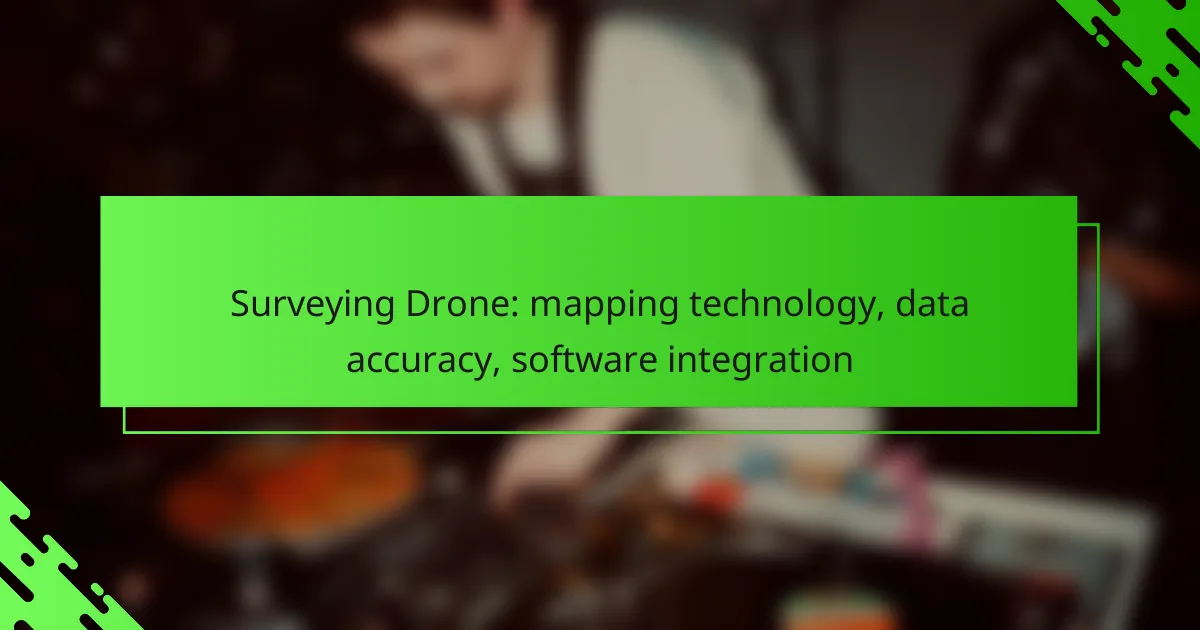Surveying drones are revolutionizing the field of mapping by providing high-resolution aerial imagery and precise geospatial data, significantly enhancing accuracy over traditional methods. These advanced technologies, combined with seamless software integration, allow for real-time data processing and effective analysis, making them essential tools for modern surveying applications.
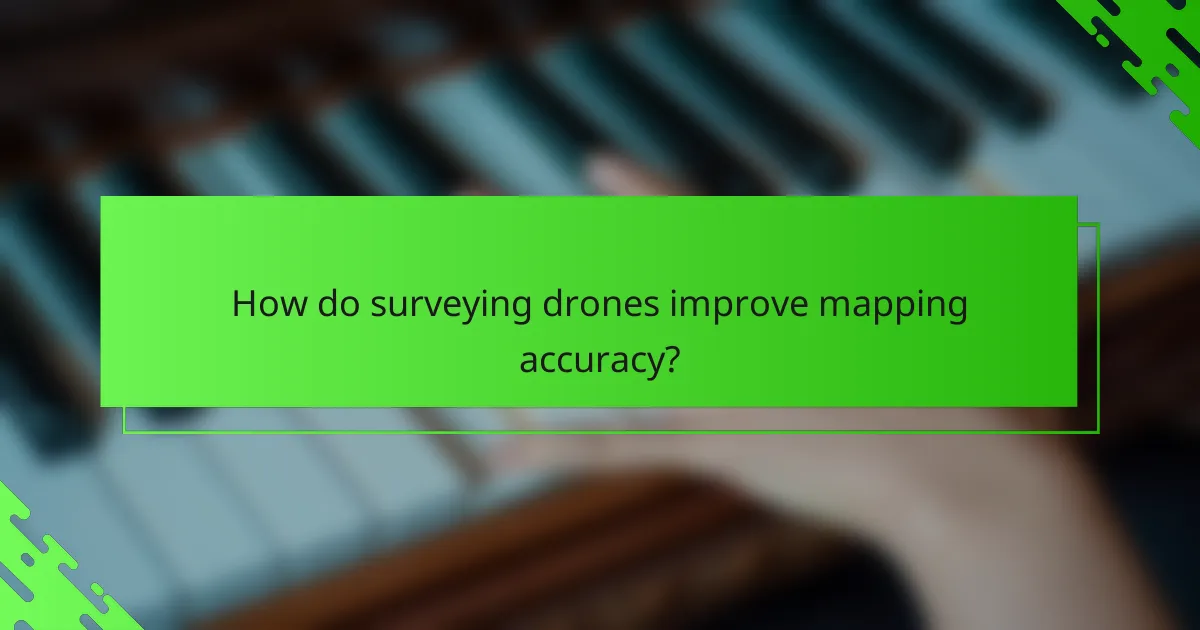
How do surveying drones improve mapping accuracy?
Surveying drones enhance mapping accuracy by capturing detailed aerial imagery and precise geospatial data. Their advanced technology allows for high-resolution outputs and real-time data processing, which significantly reduces errors compared to traditional surveying methods.
High-resolution imagery
Surveying drones are equipped with high-resolution cameras that capture detailed images of the terrain. This imagery allows surveyors to analyze features with greater clarity, leading to more accurate mapping results. For instance, images can have resolutions exceeding 1 cm per pixel, which is crucial for identifying small features in complex landscapes.
When selecting a drone for mapping, consider the camera specifications, including sensor size and lens quality. Higher resolution images can improve the overall quality of the final maps, making them more useful for applications such as urban planning or environmental monitoring.
Real-time data collection
Real-time data collection is a significant advantage of using surveying drones. Drones can transmit data instantly to the ground control station, allowing for immediate analysis and adjustments during flight. This capability helps identify and correct errors on-the-fly, enhancing the overall accuracy of the mapping process.
For effective real-time data collection, ensure that the drone’s communication systems are robust and that the software used can process incoming data efficiently. This can minimize downtime and improve the efficiency of surveying projects.
Advanced GPS technology
Surveying drones utilize advanced GPS technology to achieve high levels of positional accuracy. Many drones are equipped with Real-Time Kinematic (RTK) GPS systems, which can provide centimeter-level accuracy by correcting GPS signals in real-time. This precision is essential for applications requiring detailed topographic mapping.
When deploying a drone for surveying, verify that the GPS system meets the accuracy requirements of your project. In many cases, using RTK or Post-Processed Kinematic (PPK) systems can significantly enhance the reliability of the data collected.
3D modeling capabilities
Surveying drones can create detailed 3D models of surveyed areas, which are invaluable for visualizing terrain and structures. These models are generated using photogrammetry techniques that stitch together high-resolution images to form a cohesive three-dimensional representation.
For effective 3D modeling, ensure that the drone’s software is capable of processing the collected imagery into usable models. This technology is particularly beneficial in sectors like construction, where accurate 3D models can inform design and planning decisions.
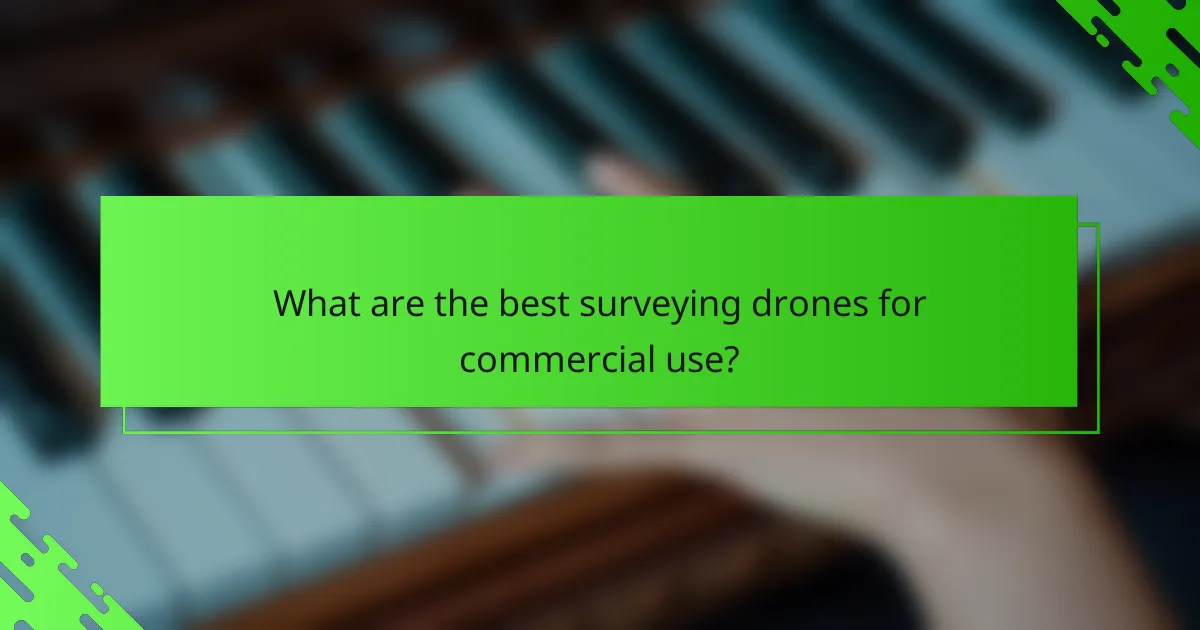
What are the best surveying drones for commercial use?
The best surveying drones for commercial use combine advanced mapping technology, high data accuracy, and seamless software integration. Key models include the DJI Phantom 4 RTK, SenseFly eBee X, and Parrot Anafi USA, each offering unique features tailored for various surveying needs.
DJI Phantom 4 RTK
The DJI Phantom 4 RTK is renowned for its high-precision mapping capabilities, making it a top choice for surveying professionals. It features a built-in RTK module that enhances geolocation accuracy to within a few centimeters, which is crucial for detailed mapping tasks.
This drone is equipped with a 20 MP camera and can capture high-resolution images, allowing for detailed analysis and modeling. Its user-friendly interface and compatibility with DJI’s Ground Station Pro software streamline the planning and execution of surveying missions.
SenseFly eBee X
The SenseFly eBee X is a fixed-wing drone designed for large area mapping, capable of covering several hundred hectares in a single flight. It offers various payload options, including RGB, multispectral, and thermal cameras, catering to diverse surveying applications.
With flight times exceeding 90 minutes, the eBee X is ideal for extensive projects. Its integration with software like eMotion allows for easy mission planning and data processing, ensuring efficient workflows for surveyors.
Parrot Anafi USA
The Parrot Anafi USA is a versatile drone that combines high-quality imaging with portability, making it suitable for various surveying tasks. It features a 32x zoom camera and thermal imaging capabilities, which are beneficial for infrastructure inspections and environmental monitoring.
This drone is designed for ease of use, with a quick setup time and a flight range of up to 4 kilometers. Its compatibility with software solutions like Pix4D makes it a practical choice for professionals looking to integrate drone data into their existing workflows.
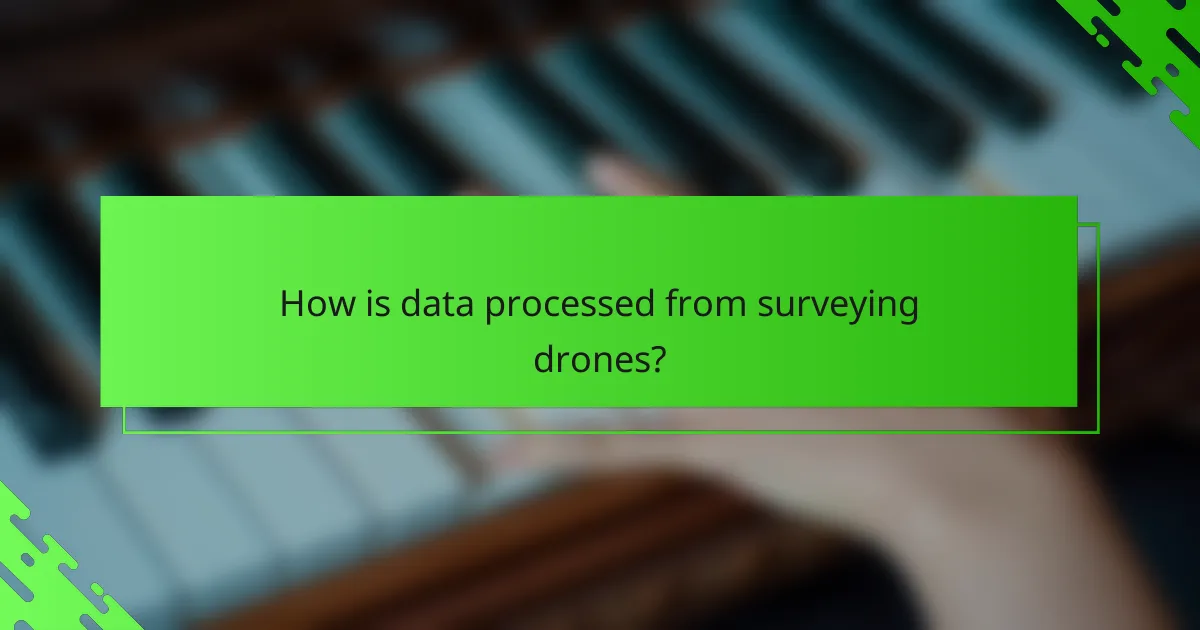
How is data processed from surveying drones?
Data from surveying drones is processed through a combination of specialized software and integration techniques that ensure accuracy and usability. This process typically involves capturing aerial imagery, converting it into usable data formats, and integrating it with geographic information systems (GIS) for analysis.
Photogrammetry software
Photogrammetry software is essential for transforming aerial images captured by drones into detailed 3D models and maps. This software analyzes overlapping images to calculate distances and elevations, creating accurate representations of the surveyed area. Popular tools include Pix4D, Agisoft Metashape, and DroneDeploy, which offer varying features and pricing to suit different project needs.
When selecting photogrammetry software, consider factors such as processing speed, output quality, and compatibility with your drone’s camera. Many programs support various file formats, allowing for easy integration with other software tools.
GIS integration
Integrating data from surveying drones with Geographic Information Systems (GIS) enhances the utility of the collected information. GIS platforms allow users to visualize, analyze, and interpret spatial data, making it easier to derive insights and make informed decisions. Common GIS software includes ArcGIS and QGIS, which can handle large datasets and provide advanced analytical capabilities.
To ensure smooth integration, verify that your photogrammetry software can export data in formats compatible with your GIS platform. This step is crucial for maintaining data accuracy and streamlining workflows.
Cloud-based data management
Cloud-based data management solutions facilitate the storage, sharing, and processing of data collected from surveying drones. These platforms enable teams to access data remotely, collaborate in real-time, and ensure data security. Services like Google Cloud and AWS offer scalable storage options that can accommodate large datasets generated during drone surveys.
When choosing a cloud solution, consider factors such as storage capacity, data transfer speeds, and security features. It’s also important to assess the costs associated with cloud services, which can vary based on usage and storage needs.

What factors influence the choice of surveying drone?
The choice of surveying drone is influenced by several key factors, including payload capacity, flight time, and software compatibility. Each of these elements plays a crucial role in determining the drone’s effectiveness for specific surveying tasks.
Payload capacity
Payload capacity refers to the maximum weight a drone can carry, which directly impacts the type of sensors and equipment it can accommodate. For surveying purposes, drones typically need to carry cameras, LiDAR systems, or other specialized sensors, with capacities ranging from a few hundred grams to several kilograms.
When selecting a drone, consider the weight of the equipment you plan to use. A drone with a higher payload capacity allows for more advanced sensors, which can enhance data accuracy and detail in mapping projects.
Flight time
Flight time is the duration a drone can remain airborne on a single battery charge, which is critical for covering large areas. Most surveying drones offer flight times between 20 to 60 minutes, depending on their design and payload.
To optimize flight time, choose a drone that balances efficiency with the required payload. Longer flight times reduce the need for frequent battery changes, allowing for more extensive data collection in a single session.
Software compatibility
Software compatibility is essential for integrating the drone with mapping and data analysis tools. Many drones come with proprietary software, while others support third-party applications, which can enhance functionality and streamline workflows.
When selecting a drone, ensure that its software can easily integrate with your existing systems for data processing and analysis. This compatibility can significantly improve efficiency and data accuracy, making it easier to produce reliable survey results.
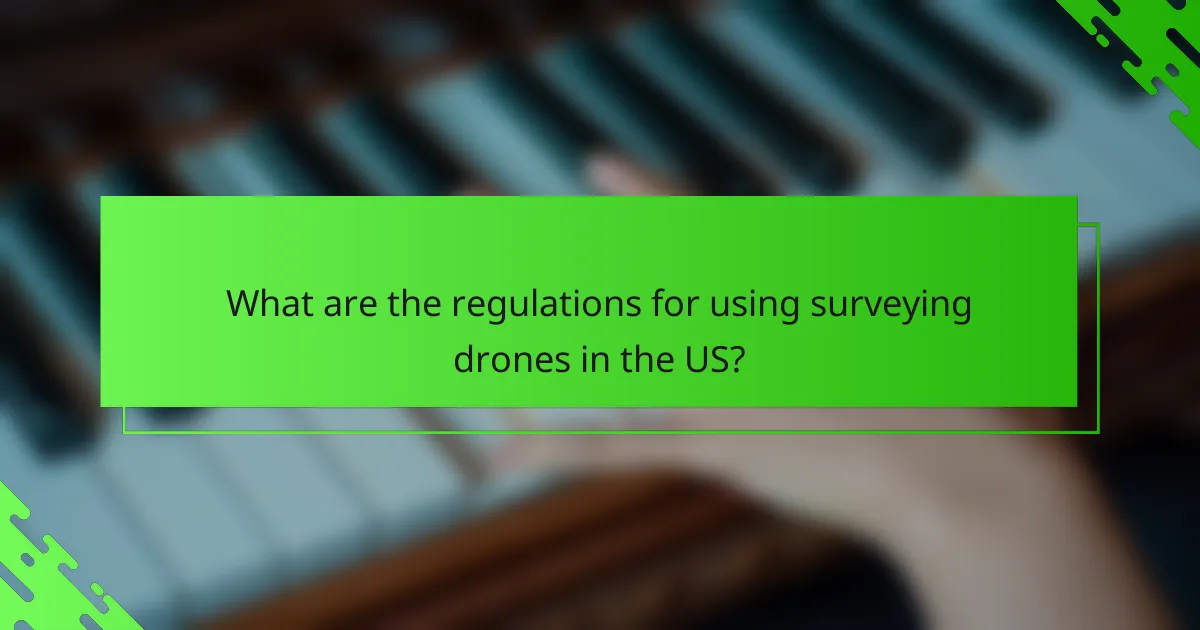
What are the regulations for using surveying drones in the US?
In the US, surveying drones must comply with specific regulations set by the Federal Aviation Administration (FAA). These regulations ensure safe operation and include guidelines on pilot certification, operational limits, and airspace restrictions.
FAA Part 107 compliance
FAA Part 107 outlines the rules for commercial drone operations, including surveying. Drones must weigh less than 55 pounds, fly below 400 feet, and maintain visual line-of-sight with the pilot. Operations in controlled airspace require prior authorization, and night flying is generally prohibited unless specific waivers are obtained.
Compliance with Part 107 is crucial for legal operation and can affect insurance coverage and liability. Operators should regularly review updates to regulations, as changes may occur that impact operational practices.
Remote pilot certification
To operate a surveying drone commercially, a remote pilot certificate from the FAA is required. This certification involves passing a knowledge test that covers regulations, airspace classification, weather, and drone operation. Applicants must be at least 16 years old and able to read, speak, write, and understand English.
Maintaining certification requires periodic renewal, which includes completing a recurrent training course or retaking the knowledge test. Pilots should stay informed about ongoing training opportunities and changes in regulations to ensure compliance and safety in their operations.
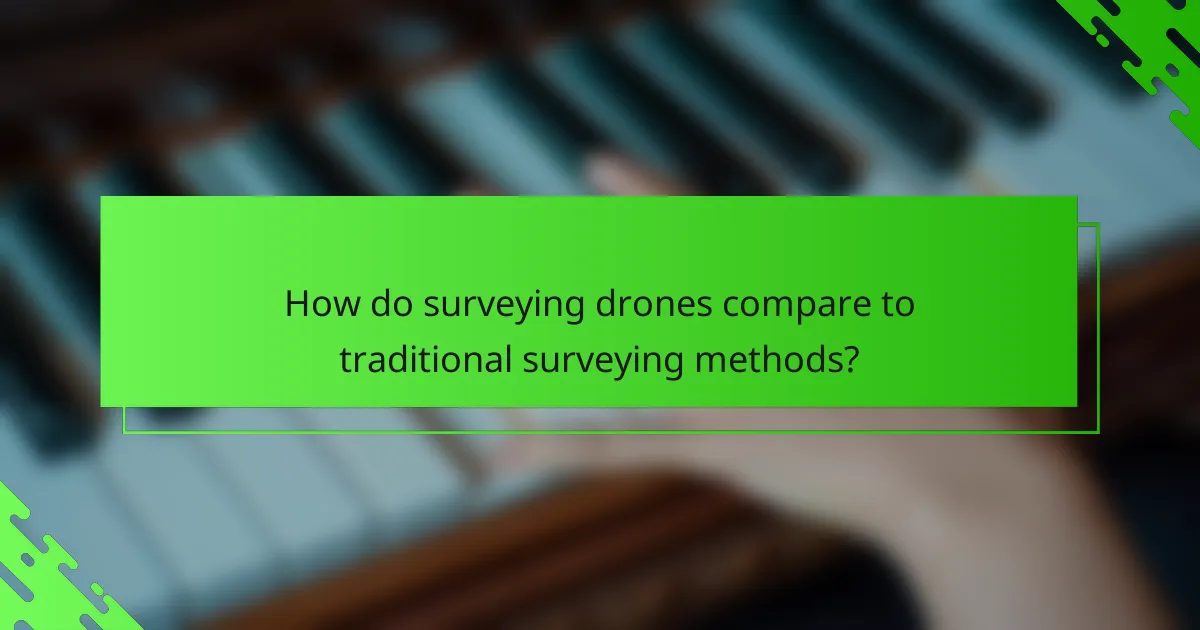
How do surveying drones compare to traditional surveying methods?
Surveying drones offer significant advantages over traditional surveying methods, particularly in terms of speed, accuracy, and data collection efficiency. While traditional methods rely on manual measurements and ground surveys, drones can quickly capture high-resolution aerial imagery and topographical data, making them a preferred choice for many surveying projects.
Cost-effectiveness
Surveying drones can be more cost-effective than traditional surveying methods, especially for large or complex sites. The initial investment in drone technology may seem high, but the reduction in labor costs and the speed of data collection can lead to significant savings over time.
For example, a drone survey may take a fraction of the time compared to ground surveys, which require multiple personnel and equipment. This efficiency can translate to lower project costs, often reducing expenses by 20-50% depending on the scale of the project.
When considering cost-effectiveness, it’s essential to factor in ongoing maintenance and software costs associated with drone operations. However, many companies find that the long-term benefits outweigh these expenses, making drones a financially viable option for modern surveying needs.
